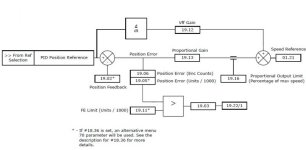Hi All, I Have a question, I am very thank full to you if help me,
I designed a flying shear controller based on fpga and microcontroller,
but the cutting error is more than 5 mm,
i want to reach cutting error to less than 1 mm,
{
The attached control block diagram is as same as control techniques documents,
best possible sample time of main loop is 2 ms,
all calculations are floating point for ease of operation // it seams it is better to change to integer for higher man loop speed
}
The main question : the control loop is optimum or not?
Thanks again for your valuable time

I designed a flying shear controller based on fpga and microcontroller,
but the cutting error is more than 5 mm,
i want to reach cutting error to less than 1 mm,
{
The attached control block diagram is as same as control techniques documents,
best possible sample time of main loop is 2 ms,
all calculations are floating point for ease of operation // it seams it is better to change to integer for higher man loop speed
}
The main question : the control loop is optimum or not?
Thanks again for your valuable time







